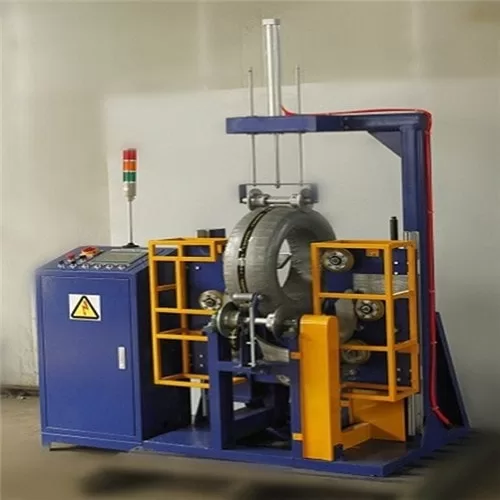Streamlining Tire Logistics: Understanding High-Speed Wrapping and Packing Machines
Handling and packaging tires efficiently and safely presents a significant logistical challenge for manufacturers, distributors, and retailers. Manual processes can be labor-intensive, slow, and risk product damage during storage and transit. High-speed tire wrapping and packing machines offer an automated solution to streamline these critical operations, enhancing productivity and product protection.
What are High-Speed Tire Wrapping Machines?
These automated systems are designed specifically for the rapid application of protective stretch film around individual tires or bundles of tires. High speed tyre wrapping machine and packing machine solutions aim to secure tires quickly, preparing them for storage or shipment.
The Automated Wrapping Process
While specific designs vary, the typical operation involves:
- Loading: Tires are fed onto the machine's conveyor or loading area.
- Securing: A mechanism, potentially a press-down device, holds the tire securely in place.
- Wrapping: A ring or rotating arm dispenses stretch film, wrapping it around the tire's circumference as the tire or the ring rotates. Tapping devices may assist in securing the film tail.
- Cutting & Sealing: Once the wrapping cycle is complete, the film is automatically cut and sealed.
- Discharge: The wrapped tire is moved off the machine, ready for the next stage (e.g., palletizing).
Key Features and System Components
Modern tire wrapping systems incorporate several features for efficiency and reliability:
- High Operational Speed: Capable of processing tires rapidly, often cited at speeds around 15-25 seconds per tire, significantly boosting throughput compared to manual methods.
- Programmable Logic Controller (PLC): These serve as the machine's brain, controlling the wrapping parameters, cycle times, and integration with other automation components. User-friendly interfaces allow for adjustments.
- Automatic Ring Reset: Ensures the wrapping ring returns to the home position efficiently after each cycle, ready for the next tire.
- Safety Mechanisms: Overload protection for motors and sensors to detect obstructions are crucial for safe operation and preventing equipment damage.
- Film Delivery System: Advanced systems manage film tension and pre-stretch (if applicable) for optimal material usage and load containment.
- Bundling Capability: Some machines can group and wrap multiple tires together, which can save space and packaging material.
http://www.fhopepack.com/Tyre_packing_machine.html
Wrapping Material Considerations
The primary material used is typically a durable, stretchable polypropylene or LLDPE (Linear Low-Density Polyethylene) film. Key properties include:
- Puncture Resistance: Protects tires from scratches and scuffs.
- Elasticity & Load Retention: Keeps the tire(s) tightly secured.
- Clarity: Allows for easy identification of the tire underneath.
- UV Resistance (Optional): Important if tires will be stored outdoors.
From Wrapping to Shipment: The Role of Packing
While wrapping protects individual tires or bundles, tire packing machines often handle the next step: preparing tires for bulk shipment. This typically involves:
- Palletizing: Automatically stacking wrapped tires onto pallets (wood, plastic, or specialized cradles).
- Securing Pallets: Using stretch hood film, additional stretch wrap, or strapping (plastic or steel) to secure the entire pallet load for stability during transport.

tyre packing machines6 Advantages of Automated Tire Packaging Systems
Implementing automated wrapping and packing offers substantial benefits:
- Reduced Labor Costs: Automates a repetitive and physically demanding task.
- Increased Throughput: Significantly faster than manual wrapping and packing.
- Consistent Package Quality: Ensures tires are wrapped uniformly and securely every time.
- Enhanced Product Protection: Minimizes damage from handling, moisture, and dirt during storage and shipping.
- Improved Storage Efficiency: Tightly wrapped individual tires or bundles can optimize warehouse space. Bundling, in particular, reduces space requirements.
- Streamlined Logistics: Creates stable, unitized loads ready for efficient transportation.
- Operator Friendliness: Modern systems often feature intuitive controls designed for ease of use by trained operators.
Typical Applications
Automated tire wrapping and packing systems are vital in various sectors:
- Tire Manufacturing Plants: Handling high volumes of newly produced tires.
- Distribution Centers: Processing tires for shipment to retailers or customers.
- Large Retail Operations: Preparing tires for storage or display.
- Automotive Aftermarket Suppliers: Packaging tires for distribution networks.
- Specialty Tire Handling: Suitable for various types, including passenger car tires, truck tires, motorcycle/cycle tires, and even specialty rims needing protection.
Implementation Considerations
Successful integration requires planning:
- Facility Requirements: Needs a stable, level floor surface, typically in a dry, relatively dust-free environment.
- Space Allocation: Sufficient footprint for the machine and operator access is necessary.
- Utilities: Adequate electrical power supply is essential.
- Material Supply: Consistent access to appropriate stretch film and other packaging consumables.
By automating the wrapping and packing process, businesses handling significant tire volumes can achieve greater operational efficiency, improve product protection, and streamline their overall logistics workflow.